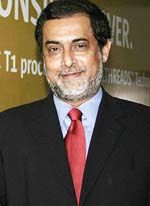 As part of its mobile-first, cloud-first strategy, Microsoft has spent close to $4.5 billion in setting up 19 data centres across the globe.
As part of its mobile-first, cloud-first strategy, Microsoft has spent close to $4.5 billion in setting up 19 data centres across the globe.
Three are in India and will be operational by the end of 2015.
Bhaskar Pramanik, chairman, Microsoft India, in an interview with Business Standard, talks about cloud adoption, the need to push mobile handset numbers and the coming Windows 10.
Edited excerpts:
Windows cloud offerings have been aggressive in India. How is the cloud being adopted here?
It is accelerating every day.
There are three core segments of cloud adoption: Consumers, enterprises and the government.
As far as the consumer is concerned, he/she moved to the cloud at least 15 years ago.
For him, privacy is not a big concern anymore.
Every company that has a data centre is trying to move to a private cloud.
We have 1.2 million customers for Office 365.
The first workload that enterprises move to the cloud is related to productivity.
We are suggesting enterprises look at their businesses and think of moving to the cloud. That is where our cloud accelerator programme kicks in.
We are asking enterprises to use this infinite computing power we are setting up in three data centres in India.
Will you gain market share by setting up data centres in India?
Our data centres are a contribution to the Make-in-India campaign. From a software company’s perspective, it is our manufacturing unit.
It is a huge investment.
I do not know any organisation that has set up data centres of this scale or capacity.
By investing in the data centres, we are trying to create a market.
If we are left where we are -- the cloud market in India is $400 million and the information technology and IT services market is $50 billion -- then India will fall behind in cloud adoption.
Given the pace the new government wants to move on and the kind of application and services it has in mind, we will not be able to execute if we do not have such infrastructure ready.
As far as the government is concerned, whenever we have had discussions with it, the conversation was about data sovereignty.
Now, no one has that issue.
After that, we looked at all the regulatory norms and outsourcing and we meet all these requirements.
Our data centres will have standards better than any of the government-owned ones.
Mobile hardware is a crucial aspect of Microsoft’s strategy, but it is struggling to gain market share. . .
On Lumia, we still have to grow our market share. It has been a challenge, we deserve a much larger share and we are working to that.
On tablets, we are not sure where the market will go.
The category came in with a bang, there was talk that the personal computer market will die, but that has not happened. I have to protect my share in the PC market. What happens to the tablet depends on how these two segments grow. My strategy is to focus on the Lumia device.
The second focus is why do we need a Windows device, why cannot we make all the applications and services available on other devices?
We already have Office and Skype on Andorid and iOS. We will keep on providing consumer and business services on all other devices.
We have had that approach with Azure. We are creating the Windows Phone ecosystem.
How significant is the PC in Microsoft’s plans?
Though the numbers have declined, piracy is still 67 per cent.
As India becomes more prosperous, enforcement becomes strict, and we educate more people that our business is growing, I would like to see greater adoption of PCs.
I think Windows 10 will transform that. People using Windows 7 and 8 will be automatically upgraded to Windows 10.
After that, there will be no future Windows because updation will happen on the go.
That means piracy will go, and people buying devices with genuine software will increase.
What can we expect from Windows 10?
It goes across every device. There will be one common interface.
It truly enables you to have multiple synchronised devices.
The difference between us and Apple is that people will have choices.
It is not about one model, or one hardware and software from one company or one app store.
Perhaps in years to come we will be in the generic devices segment and we will get back to our glory days.
Any update on the White-Fi deployment in India?
We have been told that we are just about to get a licence.
We have received tremendous interest.
We will take three months to test it and see the potential areas where we can use it.
We have spoken to several partners like banks, post offices, self-help groups etc. I am passionate about using this for rural areas, but we have received interest from cities too.
Image: Bhaskar Pramanik








